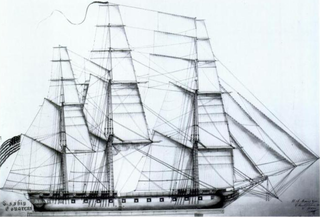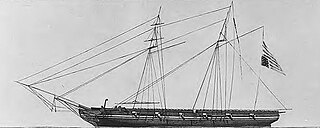Related Research Articles

A privateer is a private person or vessel which engages in maritime warfare under a commission of war. Since robbery under arms was a common aspect of seaborne trade, until the early 19th century all merchant ships carried arms. A sovereign or delegated authority issued commissions, also referred to as letters of marque, during wartime. The commission empowered the holder to carry on all forms of hostility permissible at sea by the usages of war. This included attacking foreign vessels and taking them as prizes and taking crews prisoner for exchange. Captured ships were subject to condemnation and sale under prize law, with the proceeds divided by percentage between the privateer's sponsors, shipowners, captains and crew. A percentage share usually went to the issuer of the commission.

Edward "Ned" Low was a notorious pirate of English origin during the latter days of the Golden Age of Piracy, in the early 18th century. Low was born into poverty in Westminster, London, and was a thief from an early age. He moved to Boston, Massachusetts, as a young man. His wife died in childbirth in late 1719. Two years later, he became a pirate, operating off the coasts of New England and the Azores, and in the Caribbean.

Thomas Anstis was an early 18th-century pirate, who served under Captain Howell Davis and Captain Bartholomew Roberts, before setting up on his own account, raiding shipping on the eastern coast of the American colonies and in the Caribbean during what is often referred to as the "Golden Age of Piracy".

John Evans was a Welsh pirate who had a short but successful career in the Caribbean.
Captain John Coxon, sometimes referred to as John Coxen, was a late-seventeenth-century buccaneer who terrorized the Spanish Main. Coxon was one of the most famous of the Brethren of the Coast, a loose consortium of pirates and privateers. Coxon lived during the Buccaneering Age of Piracy.

The West Indies Squadron, or the West Indies Station, was a United States Navy squadron that operated in the West Indies in the early nineteenth century. It was formed due to the need to suppress piracy in the Caribbean Sea, the Antilles and the Gulf of Mexico region of the Atlantic Ocean. This unit later engaged in the Second Seminole War until being combined with the Home Squadron in 1842. From 1822 to 1826 the squadron was based out of Saint Thomas Island until the Pensacola Naval Yard was constructed.

John Martel was a French pirate active in the Caribbean.

The West Indies Anti-Piracy Operations were a series of military operations and engagements undertaken by the United States Navy against pirates in and around the Antilles. Between 1814 and 1825, the American West Indies Squadron hunted pirates on both sea and land, primarily around Cuba and Puerto Rico. After the capture of Roberto Cofresi in 1825, acts of piracy became rare, and the operation was considered a success, although limited occurrences went on until slightly after the start of the 20th century.
Christopher Winter was an English pirate active in the Caribbean. He is best known for sailing in Spanish service and launching the career of Edward England.
Richard Noland was an Irish pirate active in the Caribbean. He was best known for sailing with Samuel Bellamy before working for the Spanish.
Joseph Thompson was a pirate from Trinidad, Cuba, and was active in the Caribbean. He is primarily known for a single incident involving grenades.
Augustin Blanco was a pirate active in the Caribbean. He was noted for attacking in open boats, and for having a mixed-race crew.
Simon Mascarino was a Portuguese pirate active in the Caribbean. He was also a privateer in service of the Spanish.
John Philip Bear, last name also spelled Beare, was a 17th-century English pirate active in the Caribbean who also served with the Spanish and French.
Jelles de Lecat was a Dutch pirate and buccaneer who sailed for and against both the English and Spanish. He served with Henry Morgan and was often called "Yellahs," "Yallahs," or “Captain Yellows.”
George Bond was an English pirate active in the Caribbean. He was known for acting in league with the pirate-friendly Governor of St. Thomas, Adolph Esmit.
Don Benito was a Spanish pirate and guarda costa privateer active in the Caribbean.
William Fox was a pirate active in the Caribbean and off the African coast. He was indirectly associated with a number of more prominent pirates such as Bartholomew Roberts, Edward England, and Richard Taylor.
Phineas Bunce was a pirate active in the Caribbean. He was pardoned for piracy but reverted to it immediately afterwards and was killed by a Spanish pirate hunter.
Nicolás de la Concepción was a pirate active off the New England coast. An escaped slave, he was one of the few black or mulatto pirate captains.
References
- ↑ Travers, Tim (2012). Pirates: A History. Stroud UK: The History Press. ISBN 9780752488271 . Retrieved 28 July 2017.
- ↑ Gosse, Philip (1924). The Pirates' Who's Who by Philip Gosse. New York: Burt Franklin. Retrieved 23 June 2017.
- 1 2 Cordingly, David (2013). Under the Black Flag: The Romance and the Reality of Life Among the Pirates. New York: Random House Publishing Group. ISBN 9780307763075 . Retrieved 28 July 2017.
- ↑ Shipley, John (2015). Little Book of Shropshire. Stroud UK: The History Press. ISBN 9780750963428 . Retrieved 28 July 2017.
- 1 2 Johnson, Captain Charles (1724). A GENERAL HISTORY OF THE PYRATES. London: T. Warner. Retrieved 18 June 2017.
- 1 2 Earle, Peter (2003). The Pirate Wars. New York: Macmillan. pp. 199–200. ISBN 9780312335793 . Retrieved 28 July 2017.
- ↑ "HMS Launceton 1721-1722". baylusbrooks.com. Retrieved 22 December 2018.
